![]()
WDI has published a series of articles tracing the rapid development of healthcare delivery and health product supply chains in low- and middle-income countries as well as management education in Central and Eastern Europe over the past quarter century.
The “25 Years of Market-Based Solutions” article series was created to honor WDI’s recently-celebrated 25th anniversary. Since its founding, WDI has studied ways that the private sector can positively impact the work on important global issues. The articles examine what advancements has been made so far, what is happening currently, the challenges that remain and what the future holds.
“The Institute’s 25th anniversary was a great opportunity to reflect on the progress we’ve witnessed and contributed to in our own work across multiple sectors,” said WDI President Paul Clyde. “We wanted to produce something that would be useful as a survey of both literature and activities to researchers and practitioners.”
One article, “25 Years of Healthcare Delivery in Low- and Middle-Income Countries,” chronicles how health outcomes across the world have improved dramatically over that time period. Deaths related to disease have decreased and people are living longer. The article highlights the importance of healthcare delivery and the role it has played in these improvements.
Several authors contributed to the article, including Clyde, Pascale R. Leroueil, who leads WDI’s Healthcare initiative, and Ekta Jhaveri, a senior research associate. Other contributors were representatives from the University of Michigan Medical School, the University of Michigan College of Engineering, George Washington School of Medicine & Health Sciences, Aravind Eye Care System and Makerere University.
A key to effective healthcare delivery is to have strong supply chains, writes Prashant Yadav in “25 Years of Health Product Supply Chain Reform: Market Forms of Organization versus Public Ownership.” Yadav, a former WDI senior research fellow, examines the evolution that has occurred in health product supply chains in low- and middle-income countries in the past 25 years, with a special emphasis on the role of market-based solutions. Yadav also studies areas where market-oriented reforms have succeeded or failed in improving supply chain performance.
The third article, “Development of Management Education in Central and Eastern Europe” looks at the growth of management education in the region and gives recommendations for its future. Authors Danica Purg and Alenka Braček Lalić of IEDC-Bled School of Management in Slovenia discuss how education institutions in Central and Eastern Europe can use management and leadership development to address emerging business issues in the region.
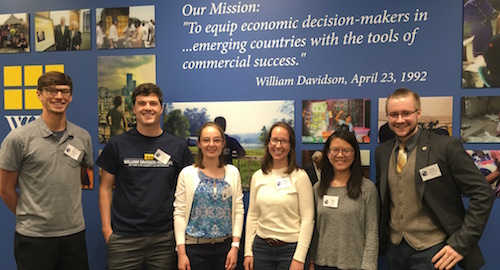
Six U-M graduate students are participating in the 2018 WDI Global Impact Internship program.
When Rebecca Grossman-Kahn was in high school, she was a volunteer with Amigos de las Américas, a youth leadership and cultural exchange program that partners with Plan International, a global development and humanitarian organization. While an undergrad at Stanford University, she worked in Honduras and Nicaragua for the organization.
“I just loved it,” she said. “I loved living in a different place, I loved speaking Spanish.”
So when the Ross School of Business MBA candidate and University of Michigan Medical School student was looking to create her own summer internship, she reached out to several organizations. The first to respond was Plan International, which works to empower children – especially girls.
“They were interested in revamping their evaluation program and I knew WDI worked in performance measurement,” Grossman-Kahn said.
She pitched the partnership to WDI as a student-initiated internship and it was approved. In mid-June, she will head to Brazil to develop a survey tool Plan International will use to assess the impact of their programs. In addition to student-initiated internships, WDI also develops student summer opportunities along with its partners.
Grossman-Kahn is one of six U-M graduate students participating in the 2018 WDI Global Impact Internship program. The students represent the Ross School of Business, the School of Public Health, the College of Pharmacy, the School for Environment and Sustainability (SEAS) and the Medical School. They will work in Brazil, India, Indonesia, Kenya, Namibia and Nepal, and support the work of WDI initiatives in Education and its Entrepreneurship Development Center, Energy, Healthcare, Performance Measurement and Scaling Impact. All of the interns have met with their respective WDI initiative leaders and will continue to keep in touch once in the field.
Colm Fay, who leads WDI’s Energy Initiative, said he is interested in understanding more about access to energy for productive use because of the impact it can have in low- and middle-income countries. Fay will be working with graduate student Matthew Carney, who will be interning at Ecoprise, which designs, builds and installs clean energy products in Nepal for energy-poor communities.
“Matt’s work with Ecoprise will provide important learnings about how an innovative business model to provide energy for agricultural loads can impact rural livelihoods, and how the well-being of these communities can be enhanced through greater access to energy,” Fay said.
Fay also directs WDI’s Scaling Impact initiative and is working on a project in Kenya with intern Andrea Arathoon. He said Scaling Impact wants to develop tools and frameworks that help enterprises achieve sustainability at scale.
“Andrea’s experience with Jacaranda, an organization that is seeking both to scale its operations as well as replicate its approach through partners, will further our understanding of the strategies and resources that are necessary to design business models for scale,” Fay said. “Her work will also provide great insights on how enterprises measure performance in terms of both sustainability and impact, and how best to frame this for investors.”
For Grossman-Kahn, her summer in Brazil will not be her first trip to the country. She lived there while participating in a study abroad program as an undergrad and learned Portuguese. She is looking forward to going back and collaborating with a familiar partner.
Grossman-Kahn said she will split her time between doing high-level strategy work in an office in Sao Paulo and observing Plan International’s programs in rural towns.
“I’m really excited about working with Plan International again,” she said. “They are really mission driven. Everyone in the organization is passionate about the work they’re doing.”
Here are the all WDI interns and their projects:
Andrea Arathoon
School of Public Health
Jacaranda Health
Nairobi, Kenya
WDI Partner: Scaling Impact initiative
Jacaranda Health operates a maternity hospital where it sees more than 2,000 clients a month and wants to create East Africa’s first truly sustainable and scalable maternal health service delivery organization. It is partnering with 15 government hospitals to refine a model for improving quality of maternal healthcare in the public sector.
Andrea will develop the latest version of Jacaranda’s business model and debt/equity financing structure for its next round of investment. She also will assess market and business model opportunities for expansion, improve profitability in the hospital by evaluating new service lines, marketing and customer insights.
Mason Benjamin
School of Pharmacy
WDI & International Pharmaceutical Federation (FIP) Hospital Pharmacy Section (HPS)
Namibia
WDI Partner: Healthcare initiative
FIP is a global federation representing 3 million pharmacists and pharmaceutical scientists worldwide. The Hospital Pharmacy Section’s objectives are to further hospital pharmacy in all its aspects, including the needs of developing countries. FIP, in partnership with WDI, is establishing a collaboration with the University of Namibia School of Pharmacy to increase the capacity of hospital pharmacists in two pilot countries, Namibia and Pakistan, through in-country diagnostics and technical assistance. The summer intern will provide preliminary research on Namibia, which will then inform next steps and content design for this collaboration in pharmacy workforce development.
Mason will develop a landscape analysis of hospital pharmacy practices in Namibia, both at private and public hospitals, in support of a larger pharmacy workforce development goal.
Nadia Putri
Ross School of Business
East Bali Cashews
Bali, Indonesia
WDI Partner: Entrepreneurship Development Center (Education Initiative)
Founded in 2012, East Bali Cashews (EBC) sources sustainably grown cashews from nearby smallholder farmers and processes them in a factory located in a remote village in one of Bali’s poorest regions. Since its launch, the company has integrated various social missions in and around their cashew processing operations, including community improvement and women’s empowerment.
For her internship, Nadia will design a U.S. market entry strategy and actionable roadmap, develop sustainable quality and efficiency improvements and create a food production “best practices” guide. Additionally, in partnership with WDI’s Entrepreneurship Development Center, Nadia will develop a strategy to support EBC’s mission for women empowerment and develop a mini case study how they would achieve it.
Chris Owen
Ross School of Business and School for Environment and Sustainability
Michigan Academy for the Development of Entrepreneurs (MADE)
India
WDI Partner: WDI President Paul Clyde
The Michigan Academy for the Development of Entrepreneurs (MADE) is a U.S.-based nonprofit organization whose aim is to develop entrepreneurs in emerging economies. MADE was founded by the William Davidson and Zell-Lurie Institutes at the University of Michigan and Aparajitha Foundation in Madurai, India. MADE provides Entrepreneurship Development Organizations (EDOs) in emerging economies a repeatable, scalable, transferable and profitable service platform to develop entrepreneurs in their home countries.
For his project, Chris will Identify best practices of existing coaching programs in India and other emerging economies, conduct a needs assessment of entrepreneurs in Madurai and develop a framework and training curriculum for how coaches will be identified, on-boarded and trained. Chris’ work continues a succession of Ross School student teams who have worked with MADE since its launch in late 2017.
Rebecca Grossman-Kahn
Ross School of Business and University of Michigan Medical School
Plan International
Brazil
WDI Partner: Performance Measurement initiative
Plan International is a not-for-profit, non-governmental organization founded in 1937. It is a development and humanitarian organization that advances children’s rights and equality for girls through various programs.
For her internship, Rebecca will develop a tool to assess the social impact of Plan Brazil’s gender equality programs; develop a framework for evaluating impact of violence prevention and girls’ empowerment programs that can be adapted to other partner organizations and in other settings. In addition, Rebecca will also analyze Plan International’s program cost structure and provide recommendations for standardizing and cost savings.
Matthew Carney
Ross School of Business and School for Environment and Sustainability
Ecoprise
Nepal
WDI Partner: Energy initiative
Founded six years ago, Ecoprise designs, builds and installs clean energy products in Nepal for the underserved, energy-poor communities in order to create positive economic, environmental and social impact. Ecoprise recently started AgroHub, a pay-as-you-go service-based business model that aims to provide access to solar-powered infrastructure for remote underserved farming communities. These hubs provide farmers with access to equipment for irrigation, clean drinking water, food-processing and refrigerated post-harvest storage as a service, with ownership of equipment remaining with AgroHub or Ecoprise.
Matthew will develop a theory of change report and a business plan for Ecoprise’s AgroHub model in western Nepal.
WDI is part of two separate grants awarded by the Reproductive Health Supplies Coalition (RHSC) Innovation Fund, the organization’s flagship initiative to spur and finance promising new ideas and strategies. The coalition, which is the largest network of reproductive health organizations, aims to ensure that a range of quality reproductive health supplies are available equally to all people who need them regardless of income.
Both grants were awarded in March at RHSC’s meeting in Brussels. The first grant was awarded to WDI’s Healthcare Initiative to study and make recommendations to improve commercial distribution of family planning products in remote and underserved populations in low- and middle-income countries (LMICs).
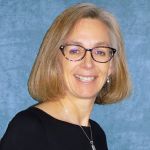
Andrea Bare
The project, “Total Market Approach: Private Sector Distributor Landscape Analysis,” is being funded by the RHSC, a global partnership of public, private and non-governmental organizations dedicated to ensuring that all people in LMICs can access and use affordable, high-quality supplies to improve reproductive health. It will be led by WDI Senior Advisor Andrea Bare and Research Associate Erika Beidelman.
Historically, low-income people living in rural areas have less access to family planning products and services partly due to market distribution barriers. Social marketing organizations (SMOs) play a vital role in improving access to, and choice of, an assortment of family planning products at a variety of prices in underserved markets. SMOs provide product-based contraceptive social marketing programs, which are funded in part by donors, making products and/or services subsidized. As donor support begins to phase out and SMOs pursue transition to greater sustainability with less dependence on subsidies, existing distribution models will be impacted.

Erika Beidelman
Global indicators suggest that the donor resource base for family planning supplies will decrease in the future, widening the existing funding gap. Further complicating the market, demand will continue to grow as countries strive to meet global family planning goals by 2020 – increasing total commodity costs required to meet women’s needs. A RHSC gap analysis showed that in 135 LMICs there will be a $238 million funding gap in 2018 which will grow to $290 million for 2020. For the years 2018-20, the combined funding shortfall is estimated to be $793 million. WDI’s research project will address the urgency of engaging the private sector and commercial distributors as part of the global effort to address the widening funding gap and ensure availability of family planning products.
Bare and Beidelman will take an in-depth look at Malawi as an example country with high donor involvement, strong SMO presence and limited commercial presence. They will then contrast what is occurring in Malawi with countries such as Vietnam, Cambodia, Guatemala or Morocco where donor funds and SMO presence are lower and the commercial distribution sector is more mature. This assessment will map what is currently working and not working for commercial distributors, with insights into their current business and service models, barriers to participation and opportunities for improvement.
By examining Malawi against the other countries, market needs, policy conditions and opportunities can be identified to foster commercial investment and participation within the distribution sector. WDI researchers are then able to develop a set of hypothetical solutions to remedy the challenges and “concept test” them with stakeholders.
The goal is to deliver a final set of potential, recommended solutions for increasing the role of the commercial sector in family planning products distribution to rural and other underserved populations.
WDI has partnered with RHSC on a past project. In 2017, WDI, RHSC and the U.S. Agency for International Development (USAID) collaborated on Market Bookshelf, an easy-to-navigate online platform to facilitate the dissemination and sharing of global health market knowledge. The goal of the platform is to increase returns on donor and other stakeholder-funded research and help advance global health objectives through knowledge-sharing.
In the second project funded by RHSC’s Innovation Fund, WDI will partner with VillageReach on a six-month project to help improve reproductive health supply chains to increase the availability of family planning products.
Many LMIC governments own and directly operate thousands of public health clinics, and spend money to get health commodities out to the clinics. But this becomes a big challenge to reliably get products out there. As a result, governments have paid more attention to more effectively design well-functioning supply chains that align with health policy.
But designing efficient and effective supply chains often requires specialized software and data-intensive analyses, which can be expensive and difficult to manage in LMIC healthcare settings. Additionally, reproductive health commodities are unique because of the need to provide multiple product options to ensure that women are able to choose the products that best suit their specific needs.
WDI developed two different tools to simplify the process of supply chain design by addressing these software and data needs challenges. Both tools use Microsoft Excel, which is widely available, and are designed to operate without requiring intensive data collection.
The first tool uses benchmark and proxy data to help health program managers quickly estimate the cost of operating their supply chain. It can also be used to examine the cost impact of any design changes they are considering, such as delivering products more or less frequently, or integrating family planning product deliveries with other types of products, like HIV malaria medicines.
“The tool allows health program managers to quickly explore these types of supply chain design questions at a high level – questions that would otherwise require a difficult and resource-intensive analysis,” said Michael Krautmann, a senior research associate for the Healthcare Initiative.
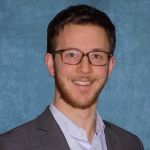
Michael Krautmann
The second tool is more strategic in nature, helping health system leaders quickly assess a wide range of factors in their country that affect supply chain performance – geography, politics, financing, human resources – and identify the types of supply chain strategies that are most aligned with that context. Again, WDI helped minimize barriers to using the tool by designing it in Excel and using data that already exists in the global health space. Together these tools allow governments or donor agencies to quickly get answers that aid in improving supply chain design.
WDI and VillageReach have been longtime partners. VillageReach has supported the work of several WDI summer interns, and the Institute’s Healthcare Initiative partnered with the global nonprofit from 2014-16 to enhance vaccine supply chain performance by evaluating mechanisms to improve accountability of vaccine program staff in three provinces in Mozambique.
Also announced at the Brussels meeting was Bare’s election as chairwoman of the RHSC’s Market Development Approaches Working Group (MDAWG). As one of RHSC’s several mechanisms through which coalition members collaborate, MDAWG is focused on the “total market,” striving to facilitate wider private sector involvement and overall market growth. RHSC uses these working groups, along with several caucuses, to bring members and partners together to build sustained, coordinated action toward specific and agreed-upon goals.
Bare’s two-year term involves several duties, including pursuing the objectives of MDAWG to:
Bare will work closely with RHSC secretariat staff to provide leadership for the group’s workstreams and activities, to ensure the visibility of its work both internally and externally and to collaborate with other RHSC working groups.
“I am grateful for this opportunity and excited to work my coalition colleagues in MDAWG,” Bare said. “Through our individual organizations and together as a group, we aim to contribute to the private sector’s development and sustainability in order to increase reproductive health access and supply security.”
Homepage image credit UNFPA Flickr
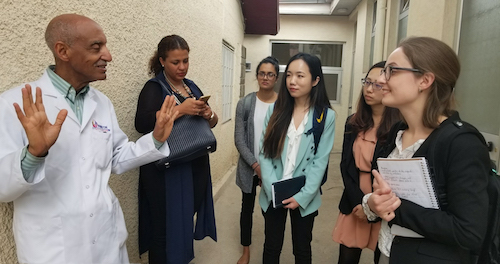
BA685 students working with Ethio-American Doctors Group (EADG) in Ethiopia interview a physician.
Qin Dong said the healthcare delivery course she took this semester taught her a lot about practices inside and outside the United States, including how healthcare organizations harnessed different business models to scale up and meet patient needs.But the biggest lesson for Dong from the weeks of classroom learning and in-country work came down to empathizing with the customer.
“My takeaway is probably true for every consulting-like project: don’t make assumptions about what is best for the customers, listen to them, and cater to their needs,” she said. “Any recommendations that don’t fit with a customer’s situation won’t be helpful at all regardless how successful it was in the past.”
Dong’s Rwanda team was one of five that spread out around the globe for the BA685: Healthcare Delivery in Emerging Markets course taught by WDI President Paul Clyde. Other teams worked in Ethiopia, India, Peru and Sri Lanka. All five teams will present recaps of their projects at 5 p.m. on April 16 in Room R1240 at the University of Michigan’s Ross School of Business. It is free and open to the public, and students in business, public health and other disciplines are encouraged to attend. A reception will follow.
Comprised mostly of MBA2 students, the course is designed to enhance participants’ international leadership capabilities, increase awareness of diverse business issues within the current global landscape, provide on-the-ground experience in a foreign country, and contribute to the success of partner health clinics and hospitals.
The course, organized and primarily funded by WDI with some financial support from Ross, responds to the increasing need for managers to have an international business perspective to augment their business and management knowledge. During the first part of the term, students learned about healthcare in emerging markets through lectures, guest speakers and case discussions. Students were then divided into five teams and prepared for visits to their selected country, traveling to those destinations in late February and early March.
The travel-study course empowers students to integrate what they learned in the classroom with hands-on experience. But unlike the Ross School Multidisciplinary Action Projects (MAP), Dong said the healthcare delivery course “exposes us to an environment where sponsors and other stakeholders have little business knowledge and no clear expectations about the projects.
“This can increase the difficulty and scope of the projects. However, it mimics real-life situations for the most part,” she said.
Clyde said the course is “business education at its best” – a collaborative learning environment with faculty and students learning from each other in an action-based learning setting.
“This course allows me to have detailed conversations with the students about some of the newer approaches to healthcare in low- and middle-income countries, and then gives them the chance to experience some of those markets in person and develop some of these new methods in concert with the institution,” Clyde said. “No matter how much I discuss it in class, there is no way to convey all of the challenges and opportunities in these markets without having the students actually visit the locations.”
Jennie Proto Gondhi, who was part of the Sri Lanka team, said she was attracted to the class to learn about the business perspective of healthcare and how business models can help solve public health problems. In pursuing a dual master’s in public health in epidemiology as well as health education/health behavior, Proto Gondhi said her classes dig deeply into evidence-based programs and validating data.
“However, I think sometimes a missing piece to public health problem solving is the idea that revenue, marketing and market value keeps programming going,” Proto Gondhi said.
She said the course showed her how valuable it is for people with public health and business skill sets to work in tandem to make a program successful.
“I enjoyed working and deliberating with teammates with varied expertise,” she said. “As we get ready to prepare our final reports and presentations, I walk away with the idea that public health programming can only be enhanced with further collaboration.”
Ross MBA student Kevin Jones, who worked with his team in Peru, called the course “probably the best interdisciplinary experience I’ve had at U-M.
“It integrates communities from the business, public health, policy and medical schools who have different but relevant perspectives on how to approach problems,” he said.
The Peru team worked with the Peruvian American Medical Society, a first-time partner for the course. The other institutions – Ethio-American Doctors Group (Ethiopia), LiveWell (India), Ruli District Hospital (Rwanda) and Grace Care Center (Sri Lanka) – have participated in the course multiple times, which allows Ross and WDI to build deep relationships and trust. Repeat partners also provides WDI with insights on what has and hasn’t worked with each institution, and that information is brought to bear in each project.
Here is a summary of each partner and project.
TEAM: Ethio-American Doctors Group (EADG)
LOCATION: Addis Ababa, Ethiopia
BACKGROUND: The Ethio-American Doctors Group is comprised of over 250 U.S. physicians of Ethiopian descent who have committed time and money to establish a state-of-the-art tertiary care hospital in Addis Ababa, Ethiopia.
PROJECT FOCUS: Develop a business model for a program to train nurses to international standards.
TEAM: Grace Care Center (GCC)
LOCATION: Trincomalee & Colombo, Sri Lanka
BACKGROUND: There is an extreme shortage of physicians in Sri Lanka and the number of people needing diabetes treatment is growing, making the shortage more acute. A GCC project looks into adding a new category of healthcare providers – diabetes technicians – to address the need.
PROJECT FOCUS: Assess the viability of a diabetic technician training program and undertake a market analysis to develop an understanding of the potential demand for such skills from existing physicians.
TEAM: LiveWell
LOCATION: Hyderabad, India
BACKGROUND: LiveWell Rehab Center in Madurai, India has been in operation since 2011. In October 2017, LiveWell began operations in Hyderabad.
PROJECT FOCUS: Examine the internal processes of the Hyderabad center compared to the Madurai facility to look for improvements.
TEAM: Peruvian American Medical Society (PAMS)
LOCATION: Chincha, Peru
BACKGROUND: PAMS Policlinico is a clinic offering multiple services, but is looking to become a center of excellence in ophthalmic surgery and gastroenterology.
PROJECT FOCUS: Conduct a market analysis to assess the profitability of a center of excellence in ophthalmic surgery and gastroenterology.
TEAM: Ruli District Hospital
LOCATION: Ruli, Rwanda
BACKGROUND: Ruli District Hospital, about two hours from Kigali, has worked with WDI for seven years and many of the projects are seeing fruit now.
PROJECT FOCUS: Study the revenue generating opportunities of a private clinic within the hospital.
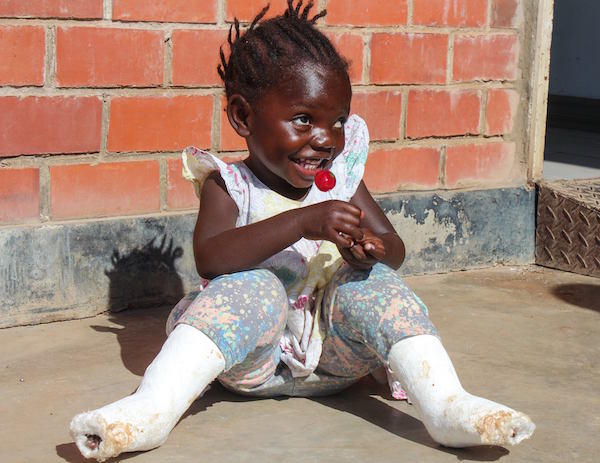
A child recovers from clubfoot treatment. Image courtesy of CURE International.
The head of WDI’s Healthcare Initiative recently spent a week in Ethiopia identifying and offering remedies for current challenges faced by the nonprofit charitable organization CURE International and its clubfoot program in that country.
CURE operates clubfoot clinics in 17 countries around the world, each tasked with helping children and families deal with the congenital deformity that twists the foot, making it difficult or impossible to walk. In Ethiopia, CURE manages 37 clinics.
Pascale Leroueil, director of the Healthcare Initiative, traveled to Ethiopia for the project, the first time the initiative has worked in the country. WDI has organized student MBA student teams from the University of Michigan’s Ross School of Business to work with CURE in the past, but in India.
“Cure officials in Ethiopia want to grow their coverage in the next two to five years to cover the entire country with clubfoot care, which is an ambitious goal,” Leroueil said. “So they were looking for some advice and our thoughts on their current challenges.”
Leroueil highlighted three areas of concern, beginning with how the nonprofit’s management reporting structure was organized and who reported to whom. Another focus was ensuring the physiotherapists and surgeons who perform clubfoot procedures are properly trained and remain up-to-date on the latest methods.
The final area highlighted by Leroueil that required attention was CURE’s ability to manufacture foot abduction braces at the scale and quality needed to treat the children with clubfoot.
To treat a child with clubfoot, ideally in the first three months of the child’s life, their affected foot is manipulated and placed in plaster casts for six to eight weeks. Often, the child’s Achilles tendon needs to be severed – an outpatient surgery done under local anesthesia. The foot is then placed in a cast again for about three weeks while the tendon grows back. After that, the feet should be in the correct position. The child will wear foot abduction braces for a few years to maintain the correct positioning of the feet.
Leroueil said a student team comprised of Ross School graduate students will soon tackle the challenge of identifying what is needed at the supply chain and brace manufacturing level for the nonprofit to scale up its coverage countrywide.
Leroueil said she gave CURE managers advice on how to address the other two issues she highlighted, and the nonprofit is deciding how best to resolve them. Leroueil said WDI is ready to assist CURE in the future.
“My hope is that our relationship with CURE will continue to grow, both in terms of student and staff projects,” she said.
Our partnership with the Ruli District Hospital (RDH) and the Ihangane Project (TIP) is to improve healthcare service delivery and operations in Rwanda’s Gakenke District. The Ihangane Project is invested in the improvement of health in the Ruli area, through the provision of material, clinical, and technical assistance to the Ruli District Hospital Health System and Ruli community members. The project scope involved analysis of cash flows within the Ruli Hospital and provide recommendations to improve hospital financial systems. The team focused on cost recovery within various departments in the hospital, and identified four opportunities around:
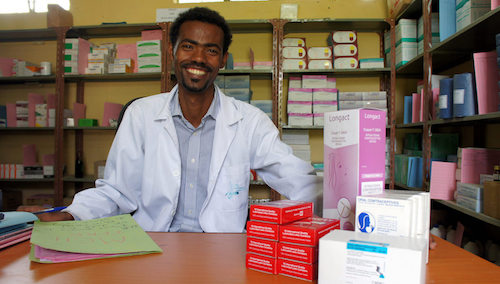
Bussa Heath Center Drugstore in Ethiopia, which is managed in partnership with USAID and the Ministry of Health. (Image credit: USAID via Flickr).
Andrea Bare is a senior advisor with the William Davidson Institute , where she partners with donor, consulting and implementing organizations to analyze global health markets and advance private sector solutions. Bare’s interview with Priya Sharma of USAID’s Center for Accelerating Innovation and Impact, originally appeared on NextBillion.net, an affiliated site of the Institute.
By Andrea Bare
As the funding landscape for global health evolves, new financing models for the development and commercialization of medicines and diagnostics are needed. Priya Sharma of USAID’s Center for Accelerating Innovation and Impact discusses the agency’s forays into impact investing, and its recent report, “Investing for Impact: Capitalizing on the emerging landscape for global health financing” in this Q&A.
When it comes to the development and commercialization of medicines and diagnostics in the U.S. and developed economies, questions of investment and impact follow a familiar equation: Pharmaceutical executives focus on what makes a good investment, while insurers, national health systems, donors and other payers press for what has the most impact.
It is not surprising that global health actors are increasingly tackling this challenging equation as well. As the funding landscape for development evolves, new financing models are needed. Private investment elevates the opportunity to achieve both financial return and social impact.
I recently caught up with Priya Sharma, senior policy and innovative financing advisor in the Center for Accelerating Innovation and Impact (CII) within USAID’s Global Health Bureau. We discussed USAID’s recent report, “Investing for Impact: Capitalizing on the emerging landscape for global health financing.”
Here are some highlights from our conversation.
AB: What is USAID’s goal behind the Investing for Impact report?
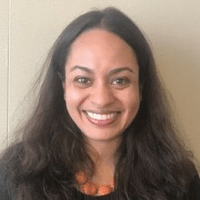 PS: We sought to highlight the movement in development finance and provide an educational resource to make the case for why it’s important for USAID to start working more with the private sector. The fact that private capital, both within countries and internationally, is outpacing donor financing in low- and middle-income countries (LMICs) is significant. Forty years ago, three out of every four dollars sent from the US to the global south came in the form of official development assistance (ODA). Today, approximately 80 percent of resource flows from the U.S. to emerging and developing economies come in the form of foreign direct investment or sources other than ODA. USAID will remain an important player, but we will have to work differently.
PS: We sought to highlight the movement in development finance and provide an educational resource to make the case for why it’s important for USAID to start working more with the private sector. The fact that private capital, both within countries and internationally, is outpacing donor financing in low- and middle-income countries (LMICs) is significant. Forty years ago, three out of every four dollars sent from the US to the global south came in the form of official development assistance (ODA). Today, approximately 80 percent of resource flows from the U.S. to emerging and developing economies come in the form of foreign direct investment or sources other than ODA. USAID will remain an important player, but we will have to work differently.
Our intent with Investing for Impact is to build understanding among USAID and development practitioners, foster a common language and highlight different tools. We make a case for continuing USAID’s current way of working but to also expand the paradigm so that when designing new projects, we actively consider the potential to leverage private funding.
AB: What are major or persistent challenges in impact investing from USAID’s vantage point?
PS: The challenge is linking appropriately designed capital with priority opportunities in global health. There are many good early stage health social enterprises (HSEs), but they may not be “investable” from the funder’s point of view. An impact investor looks for a business that is already financially viable, but promising HSEs may still require substantial technical assistance, pose a high or uncertain risk, or require a long time horizon for a return. From the USAID perspective, we want to support the pipeline and address these concerns to draw in the investment community. I’d like to see what we can do to bring more private capital in the earlier-stage, to prepare innovations for scale-up.
AB: Can you elaborate on Lulama, one of the investments cited in the study?
PS: Lulama is an excellent example of a public-private partnership addressing the development challenge of access to affordable and quality assured medicines in South Africa’s underserved areas. We are targeting the business challenges faced by private independent pharmacies. As the main source for medicines in many hard to reach communities, these pharmacies need access to quality assured commodities, business management assistance, and access to credit. USAID is working with Absa Bank, Aspen Pharmacare, GlaxoSmithKline, Imperial Health Sciences, Pharmed, and Pfizer to create Lulama, an innovative financing partnership that provides a comprehensive solution to support independent pharmacies, including proving them with access to much needed credit. To facilitate this process, USAID purchased insurance against the risk of pharmacies defaulting, unlocking $6.5 million in credit from a commodity wholesaler in South Africa. Interestingly, USAID and the pharmaceutical companies are risk sharing. The insurance only covers 50 percent of the wholesaler’s loss. The pharmaceutical companies cover the remaining 50 percent in the form of credit on the wholesaler’s next purchase from companies. The initiative anticipates averting 200,000 deaths due to improved access to medicine as Lulama scales in South Africa.
AB: How does this work link with USAID CII’s 2015 publication, “Financing Framework to End Preventable Child and Maternal Deaths”?
PS: The development financing dialogue has accelerated rapidly since 2015 and we felt that more context is needed. The Financing Framework presented tools for diagnosing financing issues as factors that are unique but may be overlooked in assessing the root causes of global health challenges. Here we delve into the changing landscape of global health financing and why private sector investment matters.
AB: Are impact investors comparably interested in health-related service as well as product innovation?
PS: If it’s a product, it’s a bit easier. It’s possible to understand how a product or technology can generate revenue. With a new service delivery model, it’s a more difficult to make a business case. But many investors also understand that a good new product is not enough. You also need the provider training, the demand generation, and an effective supply chain. There has to be an actor developing the market in-country for both demand and supply. This is an example of the potential synergy – private capital can invest in the technology and philanthropic partners in the enabling environment and market access.
There are service delivery models which are very replicable and scalable and those are certainly attractive investments. Cataract surgery like the Aravind model is a great case study for something that creates a social good but also has a solid business case. We want to find and support the development of Aravinds in other sub-sectors.
AB: How does USAID address scale in impact investing?
PS: Much depends on the innovation. There will be variation in what we can define as scale. What success looks like will vary vastly based on the innovation as well as the country context. If it’s a product, it’s easier to see how scale could be regional or global. However, many solutions are local—they are developed in the very communities that they are trying to help. In that case, scale might be reaching full coverage in that community, county or state.
We can achieve impact in a pilot project, but if we are to achieve our health goals and development goals, we need scale. That is not something that USAID can fund on its own, this is where the private sector can help.
AB: How do you create the pipeline and then move forward to funding?
PS: Multiple approaches are possible. The Grand Challenge model and similar challenge funds are fruitful ways to identify opportunities. We also have prizes and other pull mechanisms. USAID and other donors provide the seed funding to prove concepts. More recently, brokering and matchmaking platforms have emerged, such as Convergence, and the Every Woman and Every Child (EWEC) Innovation Marketplace, to link promising innovations to follow-on funding. These opportunities are a start but we still need a way to bring in more and different types of investors. For example, is there a way we can de-risk investment to catalyze additional funding from the private sector? Can we pool different types of capital to better meet the needs of HSEs and help them grow? These are questions we are actively exploring. We will pursue ways to be more purposeful and inclusive.
AB: How does country readiness inform the potential for impact investing?
PS: This is a critical question, as each country is so different. This will be a big hurdle and if we can get this right, it will help funding flow. Regulation, tax incentives, and restrictions on investor entry are all critical pieces that need to be thought through. Each country will negotiate this in its own way, and we can partner with impact investors to jointly assess these enabling environment factors.
AB: The report profiles several investment tools. Which one of these best align with impact investing?
PS: The flexible grant funding and the credit guarantee align best. We use flexible grant funding for pipeline generation, demand generation, to provide technical assistance, incubation and acceleration support. We use flexible grant capital for de-risking, either by supporting an individual HSE or by creating public goods like broader demand generation, investing alongside investors to increase confidence with the development enterprise. The Development Credit Authority (DCA) is probably the most powerful tool that USAID possesses. There are various ways that we can think about de-risking investment through this mechanism.
AB: What does the long-term look like for USAID in terms of impact investing?
PS: This will have to be a multi-stakeholder effort. USAID is not the solution but we can play an important role. We need a true partnership between public and private sectors to try and solve this problem of reaching scale with new business models, to understand where each fits in. This will not happen overnight, but if we manage to get the right partners together and to consider solutions, it could be game changing.
It’s been estimated that achieving the Sustainable Development Goals (SDGs), will require $4.5 trillion per year. That is not feasible with the current model of development. Part of the solution will be to recognize the role of non-traditional and new players such as the private philanthropic sector and impact investors. USAID will need to figure out how to attract them to the development space and how to work with them. This is the new model of development and this is how we will achieve the SDGs.
WDI today unveiled a new book for its 25th anniversary that commemorates the Institute’s history, leaders, partners and inspiring work around the world.
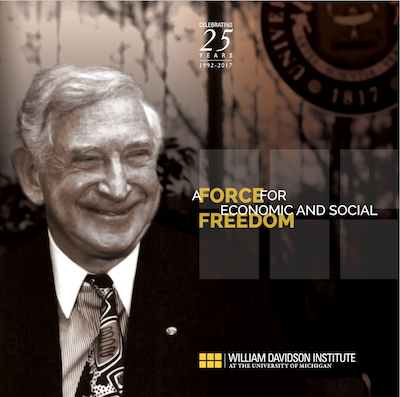 The book, “A Force for Economic and Social Freedom,” recounts the Institute’s founding and the dynamic life of its founder, Bill Davidson. The book also looks at the four people who have led WDI during its 25 years, and how each shaped the Institute in their own unique way.
The book, “A Force for Economic and Social Freedom,” recounts the Institute’s founding and the dynamic life of its founder, Bill Davidson. The book also looks at the four people who have led WDI during its 25 years, and how each shaped the Institute in their own unique way.
Four of WDI’s initiatives – Education, Healthcare, Performance Measurement and Scaling Impact – are profiled, including the goals of each and examples of some of their successful work.
The book also reflects on WDI’s 25-year engagement with the University of Michigan community – its faculty and students. Some of the Institute’s many collaborations with U-M faculty are featured, as are the numerous global internships and MBA student teams that WDI has sponsored over the years. The uplifting stories of several past WDI interns and how the opportunity to work abroad changed their lives, also can be found in the book.
The WDI Global Impact Speaker Series is discussed in the book, as well as two specialty areas of the Institute – case publisher WDI Publishing and the news and analysis site NextBillion.
The book concludes with a look to the future, and what the next 25 years and beyond hold for WDI.
The Institute received design and editorial assistance for the book from Michigan Creative, U-M’s in-house agency. Click here to download an electronic version of the book.
Located in the rural Kumi district of Eastern Uganda, Kumi Hospital was originally founded as a leprosy center by the Church Missionary Society in 1929. In 1997, Kumi Hospital started offering outreach programs and outpatient care for a wide range of medical conditions. It has 350 beds and is a leading healthcare provider in the region. Kumi operates as a non-profit entity with the intent to provide affordable care to all those who require it.
To attract and retain qualified medical staff, the project team was engaged to work on an employee morale project. It focused on identifying areas of motivation and satisfaction for the nursing staff. The goal of this project was to establish alignment of organizational policies to nursing staff morale and construct a feasible long term strategy that Kumi Hospital could use to improve and maintain nursing staff motivation.
Located in the rural Kumi district of Eastern Uganda, Kumi Hospital was originally founded as a leprosy center by the Church Missionary Society in 1929. In 1997 Kumi Hospital started offering outreach programs and outpatient care for a wide range of medical conditions. It has 350 beds and is a leading healthcare provider in the region. Kumi operates as a non-profit entity with the intent to provide affordable care to all those who require it. The hospital recovers about 37% of its expenses through patient fees and depends upon international donors, the Ugandan government and other activities as other sources of revenue. A team was engaged in a cost-cutting project that required analyzing the hospital’s current supply chain and procurement of goods. The hospital’s supply chain system included external procurement and internal distribution of goods in the following areas: Drug Procurement, Drug Distribution, Food Procurement and Central Store, Transportation, Orthopedic Workshop and Approval Process.